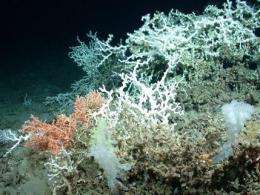Gulf corals in oil spill zone appear healthy

(AP) -- Just 20 miles north of where BP's blown-out well spewed millions of gallons of oil into the sea, life appears bountiful despite initial fears that crude could have wiped out many of these delicate deepwater habitats.
Plankton, tiny suspended particles that form the base of the ocean's food web, float en masse 1,400 feet beneath the surface of the Gulf of Mexico, forming a snowy-like underwater scene as they move with the currents outside the windows of a two-man sub creeping a few feet off the seafloor.
Crabs, starfish and other deep sea creatures swarm small patches of corals, and tiny sea anemones sprout from the sand like miniature forests across a lunar-like landscape illuminated only by the lights of the sub, otherwise living in a deep, dark environment far from the sun's reach.
Scientists are currently in the early stages of studying what effects, if any, BP PLC's April 20 oil well blowout off Louisiana and the ensuing crude gusher has had on the delicate deep sea coral habitats of the northern Gulf.
So far, it appears the area dodged a bullet, but more research is needed. Some of the deep sea corals near the spill site were only discovered just last year.
"Originally, when we saw the trajectory for the oil spill and where it was going, we were very concerned that these habitats would be impacted," said researcher Steve Ross of the Center for Marine Science at the University of North Carolina at Wilmington.
Ross and others are conducting research from a Greenpeace ship in the Gulf, using a two-man sub as they work to determine if the corals have suffered damage, or may take a hit from long-term impacts, such as stunted reproduction rates.
"We thought certainly that ... we would see signs of damage," Ross said. "And we're very pleased to say so far, that in these locations, we haven't seen a large scale damage to the coral habitats. We're still looking, but so far, it's good."
Ross was part of a team of researchers that studied deep sea corals in the Atlantic Ocean between North Carolina and Florida. The research eventually helped lead to added federal protections for a roughly 23,000 square-mile network believed to be among the largest continuous distribution of deep water corals in the world.
Ross and others have now turned their attention to the Gulf.
While fishermen have for centuries dragged up corals from the deep sea, it wasn't until the early 1900s that scientists discovered these extensive cold-water reefs. And it wasn't until the 1970s that researchers were able to use subs and cameras to reach the sea floor to document them. It had long been thought coral reefs only formed in shallow, warm waters.
Deepwater reefs and pinnacles are much more slow-growing and can take several million years to form. Science is only now beginning to understand these underwater "frontier zones." Researchers are looking to these regions for the development of additional pharmaceuticals since these cold-water critters have adapted to live in such unique environments void of sunlight, they possess unusual qualities that federal scientists say could aid in creating new drugs for cancer, heart disease and other ailments.
"We are very interested in any potential damage to deep sea corals," said Steve Murawski, chief fisheries scientist for the National Oceanic and Atmospheric Administration, which is currently conducting research into oil in Gulf sediments, among other studies.
The federal government maintains much of the oil is now gone from the Gulf, but some studies indicate it remains in significant amounts on the sea floor. Microscopic particles have also been found in the water column.
It is now a prime time for coral spawning in the Gulf, when the corals release tiny larvae that eventually form new corals.
"It could alter the reproduction of these animals," Murawski said. "Even though the adults may survive the event, did we lose the opportunity to have more juveniles produced?"
Sandra Brooke, coral conservation director at the Marine Conservation Biology Institute, who is also participating in the research, agreed. The corals' reproduction rates will be studied over the coming weeks, she said.
"We have to be careful with our conclusions about this kind of data," Brooke said, noting it will take more than just a few dives to determine the extent of the damage. "We'll take further analysis but from what we've seen so far, it seems like they've dodged a bullet."
Long-term impacts, for instance, from 1989's much smaller Exxon Valdez spill in Alaska took years, even decades to understand.
"We're just going to have to continue watching," said Margot Stiles, a marine scientist with the conservation group Oceana.
©2010 The Associated Press. All rights reserved. This material may not be published, broadcast, rewritten or redistributed.

















